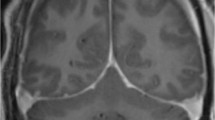Abstract
Alterations of the intracranial pressure (ICP) may be present in several conditions. The aim of this brief review is to focus on two relatively rare conditions characterized by alterations in cerebro-spinal fluid dynamics—Spontaneous Intracranial hypotension (SIH) and Idiopathic Intracranial hypertension (IIH)—in which headache is one of the key symptoms. The most relevant clinical features, the expected MRI findings, and the therapeutic options regarding both conditions are discussed.
Similar content being viewed by others
References
Steiner LA, Andrews PJ (2006) Monitoring the injured brain: ICP and CBF. Br J Anaesth 97(1):26–38
Rangel-Castilla L, Gopinath S, Robertson CS (2008) Management of intracranial hypertension. Neurol Clin 26(2):521–541
Mokri B (2001) The Monro-Kellie hypothesis: applications in CSF volume depletion. Neurology 56(12):1746–1748
Schievink WI (2008) Spontaneous spinal cerebrospinal fluid leaks. Cephalalgia 28(12):1357–1360
Headache Classification Subcommittee of the International Headache Society (2004) International classification of headache disorders, 2nd edition. Cephalalgia 24
Schievink WI (2006) Spontaneous spinal cerebrospinal fluid leaks and intracranial hypotension. JAMA 295(19):2286–2296
Mea E, Chiapparini L, Savoiardo M, Franzini A, Grimaldi D, Bussone G, Leone M (2009) Application of IHS criteria to headache attributed to spontaneous intracranial hypotension in a large population. Cephalalgia 29(4):418–422
Pleasure SJ, Abosch A, Friedman J et al (1998) Spontaneous intracranial hypotension resulting in stupor caused by diencephalic compression. Neurology 50(6):1854–1857
Radhakrishnan K, Ahlskog JE, Garrity JA et al (1994) Idiopathic intracranial hypertension. Mayo Clin Proc 69(2):169–180
Wall M (1991) Idiopathic intracranial hypertension. Neurol Clin 9(1):593–617
Schievink WI (2003) Misdiagnosis of spontaneous intracranial hypotension. Arch Neurol 60(12):1713e8
Schievink WI, Maya MM, Moser F et al (2007) Frequency of spontaneous intracranial hypotension in the emergency department. J Headache Pain 8(6):325e8
Szeinfeld M, Ihmeidan IH, Moser MM et al (1986) Epidural blood patch: evaluation of the volume and spread of blood injected into the epidural space. Anesthesiology 64(6):820e2
Franzini A, Messina G, Nazzi V, Mea E, Leone M, Chiapparini L, Broggi G, Bussone G (2010) Spontaneous intracranial hypotension syndrome: a novel speculative physiopathological hypothesis and a novel patch method in a series of 28 consecutive patients. J Neurosurg 112(2):300–306
Friedman DI, Jacobson DM (2002) Diagnostic criteria for idiopathic intracranial hypertension. Neurology 59(10):1492–1495
Randhawa S, Van Stavern GP (2008) Idiopathic intracranial hypertension (pseudotumor cerebri). Curr Opin Ophthalmol 19(6):445–453
De Simone R, Ranieri A, Bonavita V (2010) Advancement in idiopathic intracranial hypertension pathogenesis: focus on sinus venous stenosis. Neurol Sci 31(Suppl 1):S33–S39
Wall M (2008) Idiopathic intracranial hypertension (pseudotumor cerebri). Curr Neurol Neurosci Rep 8(2):87–93
Parizel PM, Makkat S, Jorens PG et al (2002) Brainstem hemorrhage in descending transtentorial herniation (Duret hemorrhage). Intensive Care Med 28(1):85e8
Agid R, Farb RI (2006) Neuroimaging in the diagnosis of idiopathic intracranial hypertension. Minerva Med 97(4):365–370
Brodsky MC, Vaphiades M (1998) Magnetic resonance imaging in pseudotumor cerebri. Ophthalmology 105(9):1686–1693
Conflict of interest
The author declares that he has no actual or potential conflict of interest in relation to this article.
Author information
Authors and Affiliations
Corresponding author
Rights and permissions
About this article
Cite this article
Mea, E., Franzini, A., D’Amico, D. et al. Treatment of alterations in CSF dynamics. Neurol Sci 32 (Suppl 1), 117–120 (2011). https://doi.org/10.1007/s10072-011-0559-7
Published:
Issue Date:
DOI: https://doi.org/10.1007/s10072-011-0559-7




